Death of Superman changed the game for superhero death 30 years ago
'Death of the Justice League' was inspired by the 1992's 'Death of Superman'
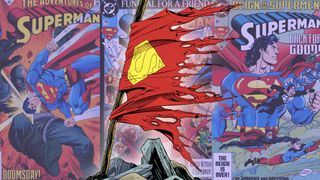
The entire Justice League is currently presumed dead (while actually being trapped in alt-realities) in the current limited series Dark Crisis on Infinite Earths. But even with the entire Justice League taking their turn on the merry-go-round of superhero death, we're reminded of the be-all-end-all of superhero death and return stories that turns 30 this year: that of Superman, figurehead of the Justice League.
As DC preps a 30th-anniversary one-shot revisiting the impact of Superman's death on the DC Universe, we're looking back at the impact Superman's death had on the comic industry itself, and the nature of superhero stories.
The idea of heroes returning from the dead has been part of fiction as long as, well, heroes themselves. Even in popular fiction, characters such as Sir Arthur Conan Doyle's Sherlock Holmes perished on the page, only to return later when time and authorship demanded. In terms of superheroes, the number of villains and minor heroes who seemed to die only to return with little or no fanfare in the early years of the genre is almost uncountable.
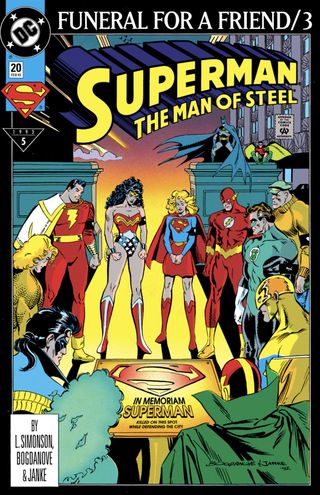
In the early '80s, Marvel Comics began popularizing the idea of superhero death and rebirth as a storytelling (and even marketing) tool 'Dark Phoenix Saga,' in which Jean Grey died only to be resurrected a few years later when the course of storytelling demanded it.
And of course, there's Marvel's first-ever graphic novel The Death of Captain Marvel, from which the title hero, Mar-Vell, has never actually returned. DC didn't shy away from the idea itself, with the deaths of Barry Allen, the Silver Age Flash, and Kara Zor-El (the original Supergirl) serving as centerpiece moments for the crossover Crisis on Infinite Earths - which was, in a way, about the death and rebirth of an entire superhero multiverse and its continuity.
But the concept of superheroes dying and returning from the dead truly took hold in 1992's landmark story 'The Death of Superman' (still some of the highest-selling comic books and then subsequent collections of all time), which took not just the comic industry but mainstream media by storm, leading to fans lining up around the block across the country to purchase copies of what was, at the time, one of the most famous stories ever told in comics.
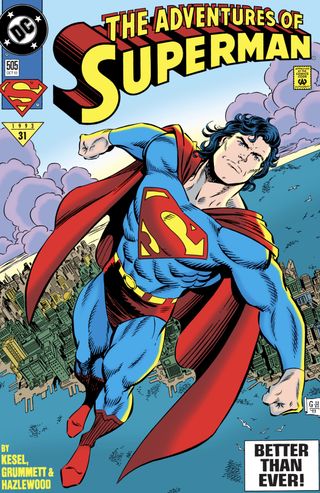
This flipped the comic industry on its head, and along with Todd McFarlane's 1990 relaunch of Spider-Man and then the subsequent 1991 X-Men relaunch by Chris Claremont and Jim Lee, 1992's 'Death of Superman' sent the comic book market into a speculation boom with sales numbers that were (and still are) nearly unheard of - all on the back of the death of one of the most popular characters in fiction.
Comic deals, prizes and latest news
Get the best comic news, insights, opinions, analysis and more!
Readers today can get salty over the fact superheroes dying and returning soon after have become commonplace and a tool to boost sales, fully embracing (and some would say chasing) the industry highs that arrived on the back of the 'Death of Superman'.
Still, Newsarama's most-read and far-reaching articles over the past few years show that, whatever fans may think of the concept, the idea of superheroes like the aforementioned Justice League or the Teenage Mutant Ninja Turtles dying remains a tried and true way to attract widespread attention and can move units like little else in the comic book industry.
But it all comes back to the 'Death of Superman' and its subsequent 'Funeral for a Friend' and 'Reign of the Supermen' arcs - the collective three-part story that codified the place occupied by superhero death and resurrection in both storytelling and comic book marketing to this day, for fans, publishers, and retailers alike.
The Death of Superman
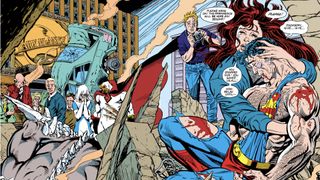
Though the idea of Superman dying wasn't brand new in 1992, it was a fresh concept for the era of more interconnected mainstream superhero comics with bigger ongoing arcs, which rarely veer into what DC once called "Imaginary Stories" that don't factor into the continued narrative of a character. This means that, for the first time, readers, retailers, and even a publisher were faced with what was purported to be the true, real death of a character of Superman's popularity in mainstream continuity, where it 'counted.'
At the time of the story, Superman had four separate ongoing titles - Action Comics, Superman, Superman: The Man of Steel, and The Adventures of Superman (a model that would later be copied by Marvel for Spider-Man, eventually leading to the idea of weekly series at both publishers, such as in the current 'Spider-Man Beyond' era). 'The Death of Superman' stretched through all four of these, as well as Justice League of America (where Superman was a central character) and Green Lantern (one of the first subsequent titles to chase the 'Death of Superman' hype for itself).
Throughout November 1992, the issues of the various Superman titles teased the arrival of a monster known as Doomsday - a threat massive enough to scare even the supposedly invulnerable Superman. When Doomsday and Superman finally clashed in Superman #75, Superman's fears were proven completely founded, as the villain managed to beat Superman to death, with the Man of Steel dying in Lois Lane's arms, surrounded by his allies in the Justice League.
The hype around Superman's death almost couldn't have been bigger. Mainstream media outlets published high-profile stories that mourned Superman almost the same way they would cover the death of an important real-world figure.
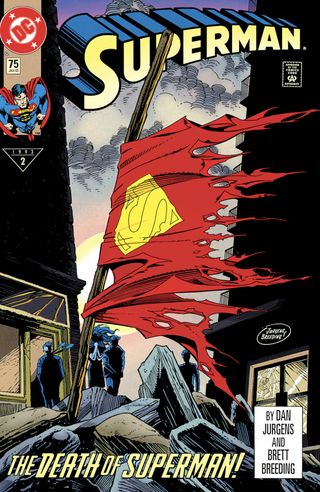
Still despite the hype, few comic shop owners or fans held onto the illusion that Superman may stay permanently dead, with some even publicly acknowledging that the story was ultimately a marketing gimmick well before it was published.
"Superman's death is being done for the same reason that a TV series may throw in a wedding: to give ratings a boost," stated Don Thompson, then co-editor of Comics Buyer's Guide, in a September 1992 Newsday article from the time, which was syndicated through numerous major newspapers.
(h/t to Superman fan-site Fortress of Baileytude who have archived numerous articles and publications from the time of the 'Death of Superman').
That same article quotes retailer Glenn Fischette of Fourth World Comics in Smithtown, New York (still open, and still owned and operated by Fischette), who told the publication "I wouldn't be surprised, and I heard this from someone else in the industry, if they reconstructed him and brought him back even more powerful."
Then as now, however, this inherent skepticism to the genre trappings of superhero comics did little to curtail sales of Superman #75 and the subsequent milestone issues of the story.
Fans flocked to retailers, lining up and waiting to hoard multiple copies of the death of Superman which, it was widely believed, would undoubtedly skyrocket in value. Few fans made their fortunes reselling those millions of copies, but retailers - who collectively moved the mind-boggling number of over six million copies of Superman #75, including variant editions - managed to make a mint for themselves and for DC, putting the burgeoning speculation boom into overdrive and sending fans flocking to buy any and all comic books they perceived could appreciate in value.
Superman - Funeral for a Friend
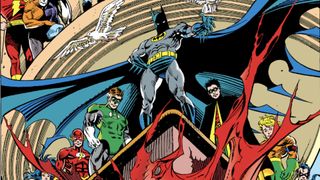
Just about everyone who doesn't actually live in the DC Universe was of the understanding that Superman would return. But in the DC Universe, Superman's death was feared to be permanent and was as momentous an occasion among Kal-El's fellow heroes as it was among fans and retailers in the real world.
The arc immediately following Superman's death was titled 'Funeral for a Friend,' and dealt with exactly what the title implies - the effect on the world of the loss of its greatest protector, and the impact of both Superman's life and death on his fellow superheroes.
The emotional tragedy of the larger story doesn't stop at Superman's death, and in fact, only ramps up in 'Funeral for a Friend'. In the wake of Superman's death, Metropolis is overrun by a wave of crime that even a team of heroes funded by Superman's former foe Lex Luthor can't overcome, while Superman's closest friends - and even some enemies - begin wearing black armbands with Superman's logo on them to openly display their mourning.
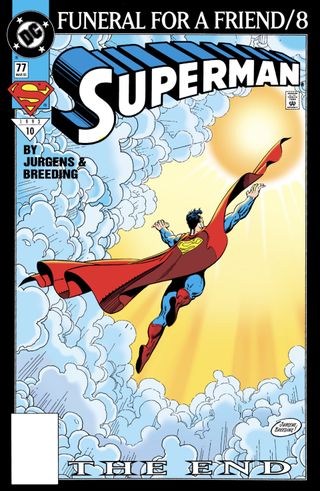
But it all caps off with Superman's human father, Jonathan Kent, suffering a potentially fatal heart attack, a compounded horror for those closest to Clark Kent just as they're already caught up in Clark's death.
In the real world, DC took another relatively unprecedented move in the wake of Pa Kent's death (pun not intended), suspending all four of Superman's ongoing titles for several months to prolong any chance at maintaining some surprise in Superman's return by delaying the publication of solicitation text that would undoubtedly give away the timeframe in which he was planned to come back, if not how it would happen (something that has only become more prevalent for modern readers thanks to the rapid turnaround of the entertainment news cycle).
This had the added impact of delaying readers' knowledge of whether Pa Kent had died or not till after the break, when it was revealed that he was still alive, but comatose - and that in his coma, he had a vision of Clark, telling him to return.
'Funeral for a Friend' wraps up with the arrival of four new heroes, each claiming the right to be Superman (or even that they truly are the original Superman, returned) - and the reveal that Superman's grave is empty.
Reign of the Supermen
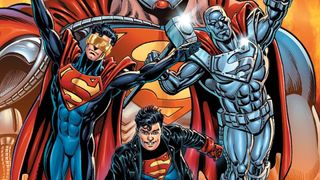
Following 'Funeral for a Friend,' DC turned to another tried-and-true superhero concept by replacing Kal-El in the mantle of Superman - sort of. This idea was, again, nothing totally new for superheroes. Just a few years prior, in the '80s, Marvel Comics had a whole wave of replacement heroes taking on established mantles, from John Walker becoming Captain America, to James Rhodes becoming Iron Man, and more.
And at DC, that idea was even more baked in thanks to the publisher having rebooted many of its Golden Age heroes (such as the aforementioned Green Lantern and Flash) as totally new characters in the '50s and '60s to kick off the superhero resurgence of the Silver Age - with the Silver Age Flash himself, Barry Allen, having been permanently replaced by his protégé/sidekick Wally West a little less than a decade before Superman's death.
But true to the story's nature, the third chapter in the saga, 'Reign of the Supermen,' kicked things up a notch by replacing Kal-El with not one but four heroes - Superboy, Cyborg Superman, Steel, and the Eradicator - each occupying one of the four Superman ongoing titles, while each also claiming to be the rightful heir to Superman's legacy.
If you were a Superman fan at the time, you undoubtedly had a favorite from among the four, all of whom have stuck around in one form or another since their introductions, with Superboy and Steel embarking on superhero careers that forged their own legacies, Eradicator and Cyborg Superman have remained recurring villains, owing to their secret malicious nature which was hidden when 'Reign of the Supermen' first started.
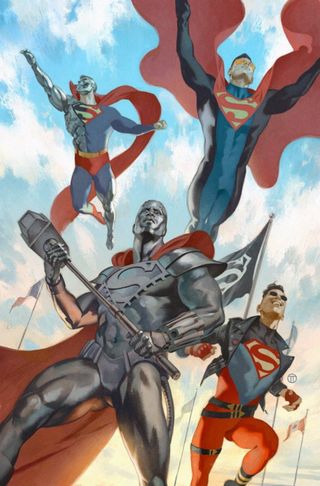
The idea was so popular that it even spun off into a video game titled The Death and Return of Superman, in which players took control of Kal-El until his death, and then played through the rest of the game as the four Supermen - until Superman's inevitable return, just as in comics.
Nowadays, it's perfectly common for multiple heroes to use the same codename - there are two Supermans, two Batmans, two Captain Americas, two Spider-Mans, who knows how many Green Lanterns, and that's just the tip of the iceberg. But in 1993, the idea of having four different versions of Superman all running around, even competing for the right to be Superman, was a fresh twist on the concept of legacy heroes.
But Superman himself had to return eventually - few folks who followed the story, be they readers, retailers, or even some of the creators, held onto the illusion that Superman's death could be permanent.
Before the story actually even started, then Superman line editor Mike Carlin stated in a faux-obituary, published in now-defunct comic distributor Capital Distributors solicitation catalog Advance Comics (h/t to Fortress of Baileytude again), that fans should recognize the possibility that Superman may come back from the dead.
"We don't really know what death means to a Kryptonian," Carlin stated at the time. "Never say we wouldn't kill Superman, never say we wouldn't bring him back."
And of course, that's exactly what happened - Superman returned with a slightly redesigned costume (the infamous mullet haircut), and after a short while resumed his life as the protector of Metropolis and the greatest hero of the DC Universe, while both his fans and his DC Universe contemporaries readjusted to his presence, after almost a full year of absence.
Superman Returns
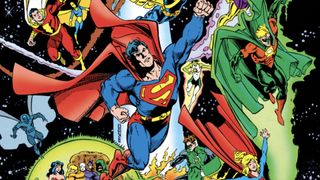
Superman's full return arrived in Adventures of Superman #505, but by the time it was on shelves, the sales bubble of 'The Death of Superman' had somewhat peaked with Adventures of Superman #500, the issue in which Superman was initially planned to return before that aspect of the story was delayed.
Still, the impact on the industry as a whole - in terms of both the expectations of fans when a superhero dies or is retired and on the way comic books are marketed to mainstream audiences that drive larger sales numbers - had already taken place by the time the Superman bubble burst and the story went back to business as usual.
DC immediately chased the spike caused by a 'death and return' type plot by killing off or retiring and replacing Green Lantern, Batman, Wonder Woman, Flash, Green Arrow, and others all in rapid succession, with varying levels of sales and story success, and Marvel followed suit in its own ways.
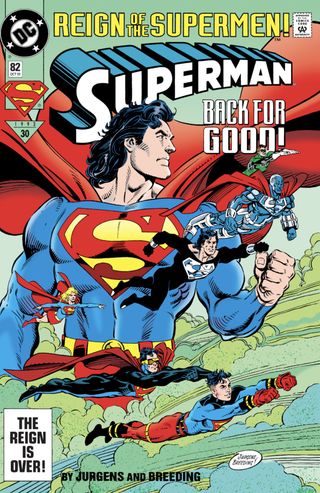
And in the years since its publication, the 'Death of Superman' has become one of the Man of Steel's most enduring stories, having been adapted as the aforementioned video game, a pair of animated films, multiple prose novels, several spiritual comic book sequels, and of course serving as a main plot point in the story of the films Batman v Superman: Dawn of Justice and Justice League.
The trend started by Superman's death and return continues to this day, with DC even specifically repeating itself on this year's 30th anniversary of Superman's death in Superman #75. April's Justice League #75 'killed off' major DC heroes, including Superman, Batman, Wonder Woman, Aquaman, John Stewart, Martian Manhunter, Zatanna, Black Canary, Green Arrow, and Hawkgirl.
But unlike 1992's 'Death of Superman', DC took a slightly different tactic with its 'Death of the Justice League' marketing, with writer Joshua Williamson doing his best to sell readers on the idea that these heroes, and the Justice League they once formed, will be dead and gone for some time to come (though we now know they'll return sometime soon).
Whatever happens, one thing is for certain - the story reporting on April's 'Death of the Justice League' was one of the most widely read and shared articles Newsarama has published in years, and nearly everyone, long time reader and non-comic fan alike, has some level of reaction to the news of death of DC's greatest heroes, with the concept even forming a large portion of the basis of the publisher's coverage at the recent Comic-Con International: San Diego.
'The Death of Superman' altered comics forever, but it took some major cues from Todd McFarlane's 1990 launch of Spider-Man #1.
I've been Newsarama's resident Marvel Comics expert and general comic book historian since 2011. I've also been the on-site reporter at most major comic conventions such as Comic-Con International: San Diego, New York Comic Con, and C2E2. Outside of comic journalism, I am the artist of many weird pictures, and the guitarist of many heavy riffs. (They/Them)
Most Popular

